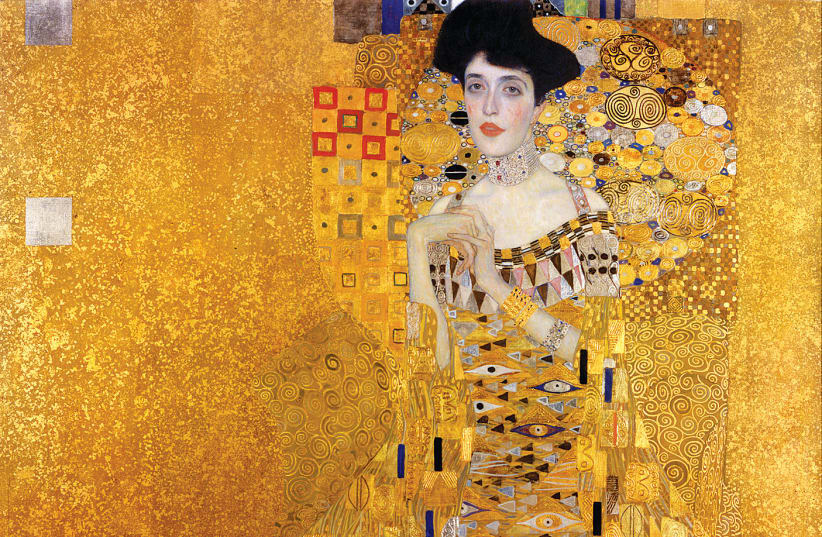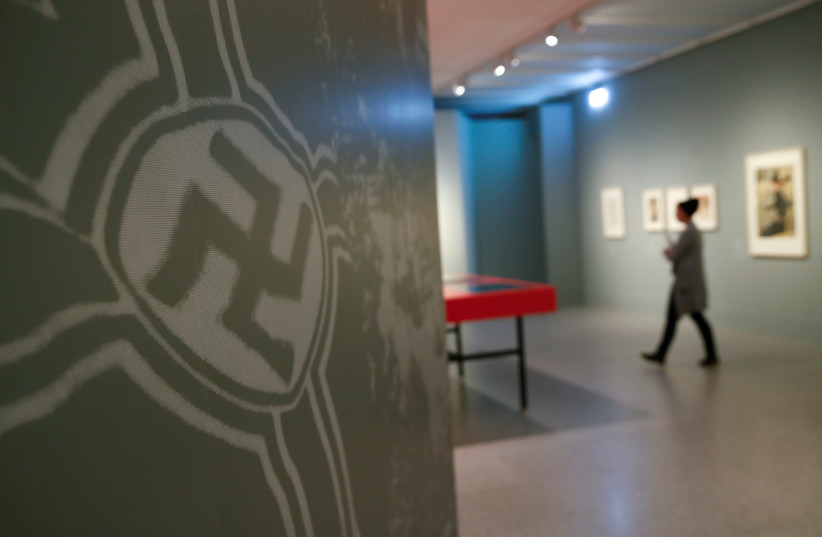Villa Semmel is a grand mansion situated on a leafy avenue in the tony Berlin neighborhood of Dahlem. The front lawn contains three flagpoles, one of which flies an Iraqi flag; the sprawling estate now serves as the embassy of Iraq. Embedded in the cobblestone sidewalk outside the main gate are two small brass plaques bearing the names of Richard and Clara Semmel.
Born into a Jewish family in Silesia in 1875, Richard Semmel moved to Berlin as a child and, upon finishing school, started working his way through the city’s clothing manufacturing industry. In 1901, he married Clara Bruck; the couple had no children. He joined the Arthur Samulon textile factory a year later and in 1919 became the company’s sole proprietor, making him an exceedingly wealthy man.
In 1925, Richard and Clara commissioned the well-known German Jewish architect Adolf Wollenberg to build them a new villa to reflect their social status and, upon its completion, started filling it with art, mostly Old Masters and contemporary French works. The Semmels acquired more than 110 pieces, including works by Picasso, Monet, Gauguin, Renoir, and Pissarro, and at least one painting attributed to Van Gogh (though this attribution is disputed).
The Kafkaesque saga of trying to recover Nazi-stolen art
In April 1933, three months after the Nazis seized power and Adolf Hitler became chancellor, Richard and Clara fled Berlin for Switzerland before finding their way to Amsterdam. While there, they were forced to auction off much of their art collection to finance their basic needs; other works were later seized by the Nazis.
In 1934, Arthur Samulon was handed over to a non-Jewish owner and the couple sold their Berlin villa for far under its market value. Richard and Clara managed to escape Holland shortly before the Nazis swept into the country in May of 1940. They found their way via Chile and Cuba to New York, where they lived in poverty. Clara died in 1945. Richard’s health deteriorated and he was cared for by a close friend and companion, Grete Gross-Eisenstädt, as he tried in vain to reacquire some of his lost property after the end of the war. He passed away in 1950, having named Grete as his sole heir.
I met Grete’s great-grandson, Daniel Levitt, on my first visit to beautiful Cape Town, South Africa, in 2016. At the time, Daniel was the executive director of the Cape South African Jewish Board of Deputies, the representative body of the local Jewish community. We have both since moved on to other roles, but we have stayed in touch, and I have seen Daniel on each of my subsequent visits. The last time I was in Cape Town, just before the pandemic, Daniel and his wife, Miriam, hosted me for a braai (barbecue) at their home, and Daniel started telling me about his family’s experience trying to recover the art that is rightfully theirs.
I was fascinated – and scandalized.
The Semmels’ art collection is currently scattered throughout the world, from Scotland to Australia, in museums, galleries, foundations, and the hands of private collectors. Working with Olaf Ossmann, a Swiss Jewish attorney who specializes in the recovery of Holocaust-era assets, Richard Semmel’s heirs have been working diligently to locate and lay claim to as many pieces of art as they possibly can. They located thirty pieces so far and are currently working on claims regarding artworks located in England, Scotland, Germany, Switzerland, the Netherlands, and the United States.
In a recent conversation, Ossmann explained to me that the restitution of Nazi-era assets is guided by the Washington Principles on Nazi-Confiscated Art, a declaration that emerged from a conference attended by more than 40 governments in Washington in 1998, which calls for the achievement of “just and fair solution[s]” to claims by the owners of confiscated art or their heirs.
Various European countries have since established commissions to handle heirs’ claims, but while these commissions can recommend that the current holders of Holocaust-era assets pursue one course of action or another, they cannot compel them to do so.
Cases like that of Daniel’s family are complicated by the circumstances under which the artworks left the possession of the original owners, Ossmann told me.
“The clear case [the commissions] had in mind was that the Gestapo moved into a [Jewish] apartment and took a painting, it ended up with Hitler, after Hitler with the US Army, and now we give it back,” he said, recalling the case of the Klimt painting, Portrait of Adele Bloch-Bauer I, depicted in the 2015 film Woman in Gold starring Helen Mirren and Ryan Reynolds.
“But most of these cases are different,” Ossmann explained. “Most of the artwork went from private people to private people to art dealers and so on, because Jewish people at the time tried to sell it in any way that was possible, in whatever currency they needed to flee.”
It has taken attorneys like Ossmann decades to convince some of the commissions to take up cases in which Jews were forced to sell their assets to save their lives and others still refuse to do so.
The sheer scope of the challenge is staggering.
In Switzerland, for example, between 50% and 60% of many museums’ collections are made up of works of art that had been owned by Jews prior to the Nazi era. Ossmann related that there are Swiss museums in which – by the directors’ own admission – some 70% of the total collection was purchased from Jewish collections during the period of Nazi persecution.
Most galling, perhaps, are the situations in which the current holders of artworks acknowledge the claims of the victims’ heirs but nevertheless refuse to return them on the grounds that it is in the “public interest” that they remain on display. Such cases tend to rely on arbitrary scales of “closeness” to the original owner to determine whether the heir’s claim is stronger than that of the current holder of the art – someone who recalls seeing a piece of art in his or her home, for instance, would be said to have a more compelling claim than the descendant of a legal heir who is not a blood relative.
In the latter case, an institution might say that its claim to the artwork is stronger than that of the rightful heirs – even as it acknowledges that, legally, he or she has a valid case – because the piece is central to its collection and its absence would be against the public interest. Various national commissions have accepted this twisted reasoning and ruled accordingly.
Incredibly, some claims aren’t heard at all because – in Germany, for example – for the commission to consider a case, both parties have to agree. In Bavaria, Ossmann told me, the local cultural institutions refused to submit a case to the commission because they had decided that the heirs had no legitimate claim. It took a legislative initiative by the Bavarian parliament to force the local government to agree to go the commission, and the commission decided within three months to return the artwork to the heirs.
As Holocaust survivors pass away and their numbers dwindle, the race to recover their art becomes ever more urgent. Cases can stretch on for years.
“From the perspective of the public institutions and the museums, the longer it takes, the better it is for them,” Daniel told me during a recent conversation in Jerusalem. “The artwork sits on the wall, it draws in crowds, it’s of value to the museum, and they’ll drag their feet as long as they can. That’s one of the biggest challenges.”
I asked Daniel how his mother, Grete’s granddaughter, feels about the disappearance of her family’s art.
“She often thinks about her mother and the struggles she went through,” he said. “As a family member, you feel that pieces that belonged to the family are being held by people to whom they’re totally irrelevant and from which they are totally disconnected. There’s a loss. It hurts, and justice is due.”

